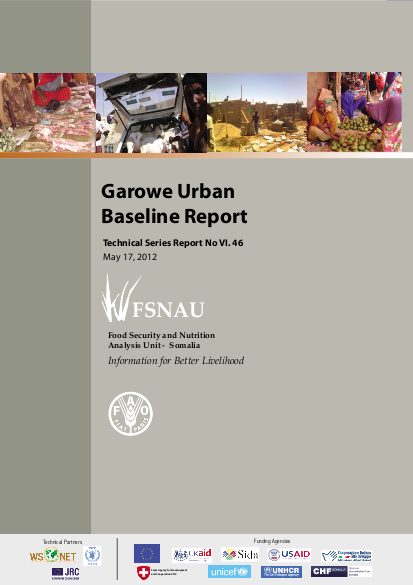
Between 16th April and 11th May 2011 FSNAU conducted a baseline livelihoods assessment of Garowe town. The main objectives of the study have been to analyze the performance of different socio-economic sectors in Garowe and their importance in sustaining urban livelihoods; to assess the linkages between the urban livelihood system and the surrounding rural and urban areas within Somalia as well as with countries outside Somalia; to examine the key risks (including gender dimensions) that predispose the urban poor to livelihood and food insecurity; to identify key monitoring indicators that can inform sustainable urban interventions related to advocacy, programming and development planning; and to build the capacity of key partners on the use of HEA and SLA frameworks in urban baseline surveys. This study applies FSNAU’s expanded Baseline Livelihood Analytical framework which integrates the Household Economy Approach (HEA), the Sustainable Livelihoods Approach (SLA) and market analysis for contextualizing and crosschecking livelihood information. To aid data collection Garowe town was divided into seven quarters or sections (degmo) and further subdivided into 27 sub-sections (laan). From these a total of 59 wealth groups and seven community representative interviews were conducted. The reference year for the baseline study was January-December 2011 because this was the most recent full commercial period making recall of events easier.
Resource collections
- Climate emergency
- Evaluating humanitarian action
- Monitoring and Evaluation (M&E)
- Monitoring of humanitarian action
- Somalia humanitarian response
- Topics
- UN Habitat - Urban Response Collection
- Urban Response - Urban Crisis Preparedness and Risk Reduction
- Urban Response Collection - Community Engagement and Social Cohesion
- Urban Response Collection - Economic Recovery
- Urban Response Collection - Environment and Climate Change
- Urban Response Collection - Housing, Land and Property
- Urban Response Collection - Urban Crisis Response, Recovery and Reconstruction
- Urban Response Collection - Urban Resilience
- Use of evaluation evidence
